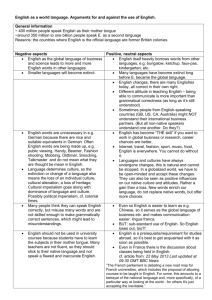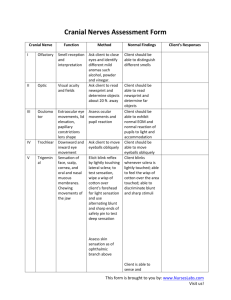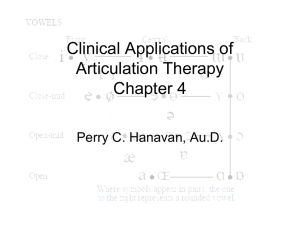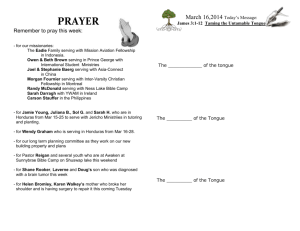Suggested Clinical - Orofacial Myology
advertisement
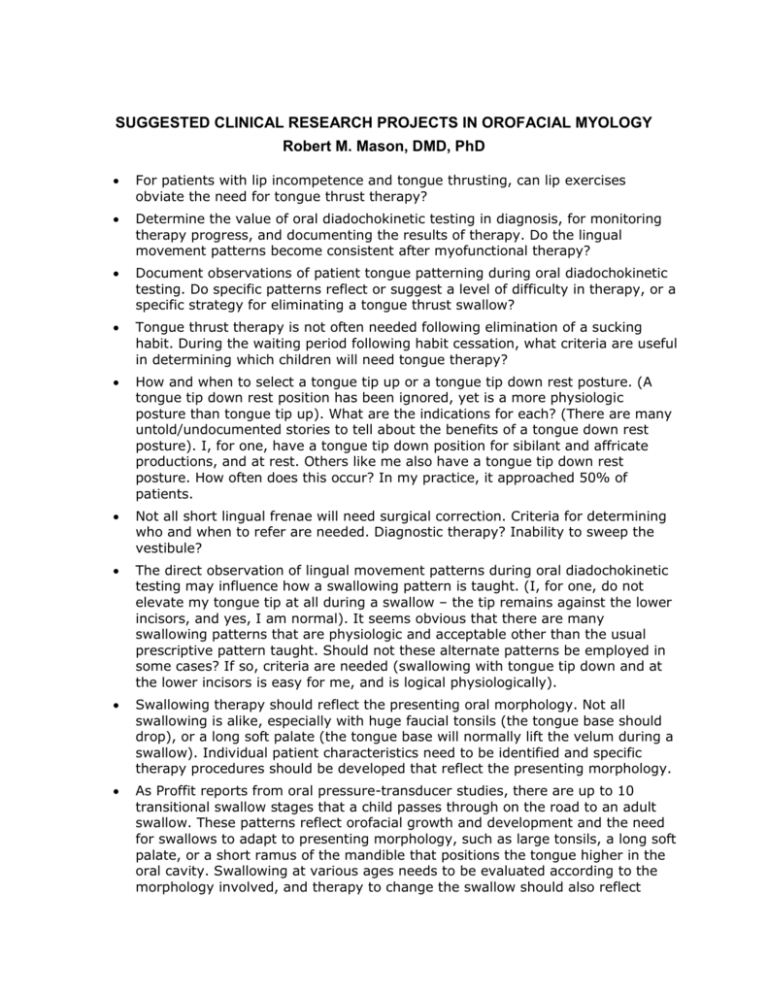
SUGGESTED CLINICAL RESEARCH PROJECTS IN OROFACIAL MYOLOGY Robert M. Mason, DMD, PhD For patients with lip incompetence and tongue thrusting, can lip exercises obviate the need for tongue thrust therapy? Determine the value of oral diadochokinetic testing in diagnosis, for monitoring therapy progress, and documenting the results of therapy. Do the lingual movement patterns become consistent after myofunctional therapy? Document observations of patient tongue patterning during oral diadochokinetic testing. Do specific patterns reflect or suggest a level of difficulty in therapy, or a specific strategy for eliminating a tongue thrust swallow? Tongue thrust therapy is not often needed following elimination of a sucking habit. During the waiting period following habit cessation, what criteria are useful in determining which children will need tongue therapy? How and when to select a tongue tip up or a tongue tip down rest posture. (A tongue tip down rest position has been ignored, yet is a more physiologic posture than tongue tip up). What are the indications for each? (There are many untold/undocumented stories to tell about the benefits of a tongue down rest posture). I, for one, have a tongue tip down position for sibilant and affricate productions, and at rest. Others like me also have a tongue tip down rest posture. How often does this occur? In my practice, it approached 50% of patients. Not all short lingual frenae will need surgical correction. Criteria for determining who and when to refer are needed. Diagnostic therapy? Inability to sweep the vestibule? The direct observation of lingual movement patterns during oral diadochokinetic testing may influence how a swallowing pattern is taught. (I, for one, do not elevate my tongue tip at all during a swallow – the tip remains against the lower incisors, and yes, I am normal). It seems obvious that there are many swallowing patterns that are physiologic and acceptable other than the usual prescriptive pattern taught. Should not these alternate patterns be employed in some cases? If so, criteria are needed (swallowing with tongue tip down and at the lower incisors is easy for me, and is logical physiologically). Swallowing therapy should reflect the presenting oral morphology. Not all swallowing is alike, especially with huge faucial tonsils (the tongue base should drop), or a long soft palate (the tongue base will normally lift the velum during a swallow). Individual patient characteristics need to be identified and specific therapy procedures should be developed that reflect the presenting morphology. As Proffit reports from oral pressure-transducer studies, there are up to 10 transitional swallow stages that a child passes through on the road to an adult swallow. These patterns reflect orofacial growth and development and the need for swallows to adapt to presenting morphology, such as large tonsils, a long soft palate, or a short ramus of the mandible that positions the tongue higher in the oral cavity. Swallowing at various ages needs to be evaluated according to the morphology involved, and therapy to change the swallow should also reflect morphological features. Such documentation, with clinical guidelines, is needed. The answer should not be to force an adult swallow on all children. Not all patients with a tongue thrust swallow should undergo therapy due to age or morphologic findings that can obligate a tongue thrust swallow. Criteria are needed for how to identify those patients with a tongue thrust swallow that should not receive therapy due to morphologic conditions involved. The therapy strategy of creating a normal freeway space by having a dentist make a niteguard-type appliance and then using it to habituate a normal vertical dimension should be implemented. Such an appliance need not cover the anterior teeth or the spot area so that normal speech can be maintained. The use of a soft (and inexpensive) niteguard-type appliance as a part of therapy to stabilize a normal vertical dimension presents an opportunity to work cooperatively with dental referral sources. Other strategies for stabilizing a normal vertical interocclusal dimension (that is, the freeway space) should be developed and documented, such as the use of the flat part of a tongueblade between teeth as the patient gently bites down. Other creative strategies need to be developed, documented, and shared. The current focus of tongue thrust therapy has been the functions and rest position of the anterior tongue. Strategies and conditions in which the tongue base would benefit from being habitually repositioned inferiorly should be identified and documented. As mentioned in the Gathering Clinical Research Data in Orofacial Myology article on this website, evaluating tongue posture from lateral cephalometric x-ray films (lateral “cephs”) via tracing the tongue height relative to the palatal plane and also documenting the vertical and horizontal position of the hyoid bone according to presenting morphology (Class I, II and III skeletal and dental patterns) presents an opportunity for a landmark study that could be done collaboratively with an orthodontist, or a group of orthodontists. For any meaningful statistical analyses, 30 or more subjects would be needed for each group involved. (Such a study would be an excellent topic for a thesis by an orthodontic resident in a university-based orthodontic training program. You could become a part of this study by virtue of serving as a learning experience and the possible clinical applications to orofacial myofunctional therapy). There is a great need to educate dentists and orthodontists about the link between resting tongue posture and the position of teeth, and the lack of a link between tongue thrusting and dental malocclusions. An epidemiological study needs to be done of how many patients referred by dentists for tongue thrust therapy also have an anterior rest posture. Such information is needed to dispel the myth that tongue thrusting is the issue and link with developing malocclusions. It would be rare to find an orthodontist or dentist that includes an anterior rest posture of the tongue on their problem list. This is sad because of the link with malocclusions that has incorrectly been blamed on the tongue. Collecting data from orthodontic offices as to the presence or absence of an anterior tongue rest posture, along with a tongue thrust, will eventually dispel this myth. In any way possible, dentists need to be apprised of the importance of identifying a forward tongue rest posture in patients. Any study of the morphological differences between groups of tongue thrusters with and without a forward, interdental tongue rest posture should be revealing. Specific observations to be recorded from lateral cephs are detailed in the article Gathering Clinical Research Data in Orofacial Myology. One topic that is in desperate need of clarification and documentation is the loose and incorrect use of the observation of “muscle tone”, or especially “low muscle tone” that represents a diagnosis made by simply looking at structures rather than measuring the level of muscle tone in some fashion. There is a great need to develop instrumental measures to measure muscle tone, or a lack of, or to describe muscle tone by using resistance measures to estimate the level of muscle tone in selected areas. Surface and needle EMG may possibly be applied appropriately to the evaluation and description of muscle tone. Hopefully, all would agree that a description of a patient having “low muscle tone” does not represent a documented observation, nor should a visual analysis of the tissues involved be accepted as an accurate description of a patient.


